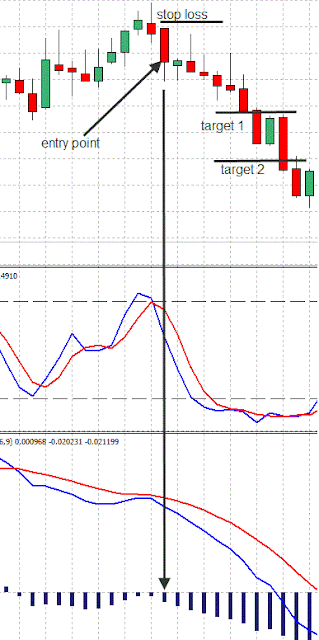Momentum
with Stochastic and MACD Trading System is strategy for swing
trading.
Time
frame 60 min, 240, min, daily and weekly.
Currency
pairs: any.
Forex
Indicators:
MACD
(12,26, 9).
Stochastic
oscillator (5,3,3) eith 20 and 80 levels.
Trading
Rules
Buy
When
the histogram is above zero level, the currency is on an uptrend.
Then
we want it to start declining towards the zero level.
After
it nears the zero level, we want it to reverse and go up again.
How
should we enter a long (buy) trade?
First we need to recognize a turning point on the MACD histogram.
This
means that the blue histogram bars should be above the zero level,
and
then it should start declining. Finally it should reverse and go up
again.
After we've made sure that conditions are met on the MACD
histogram,
we should turn to the Stochastic indicator and see its
position:
we need it to be on the oversold area (around level 20); we
want
the two lines to cross each other; and we want the lines to face up.
We
want at least one of the averages to be below level 20.
Now
is the moment we should determine our exact entry point. The
moment
we see the histogram rise again and the stochastic decrease to
the
oversold zone, we need to wait for the candlestick that created this
condition
to close.
As
soon as the candlestick is closed, we should enter this trade.
Let's
analyze a long trade example:
In
this example we can clearly see that the histogram is facing up again
and
that the Stochastic lines have crossed each other on the oversold
level,
on their way up.
The
histogram is facing up and the stochastic lines have crossed each
other
on the oversold zone, level 20.
There’s
a very important point I would like to add. It refers to a situation
where
the histogram is above level 0 and declines below level 0.
If
it happens (i.e., if it declines below level 0), it has to reverse
and
return
immediately above this level on the next bar in order for this to
be
a valid trade setup.
We
place the stop loss 1 pip below our base candlestick, which is the
candlestick
where all the conditions have been met.
For
Example:
Here
I’ll close the trade in two parts: 80% of the trade will be closed
initially,
and then I’ll close the remaining 20%.
First
Take Profit Target
My
first take profit goal is to set a profit target of a 1:1 ratio
between
the
stop loss and the take profit.
For
example: If I risk 50 pips, my take profit target will be 50 pips.
When
the
price reaches the first take profit target, I’ll close 80% of this
trade.
Second
Take Profit Target
After
the first part of the trade has been closed, I will move the stop
loss
to
the breakeven point (that is, I’ll change it to the trade’s
opening
price).
The
second profit target is twice the stop loss.
For
example: If I’ve risked 50 pips my second profit target is
100 pips.
This
is a screen shot of target 2:
That's
it…
Our
first take profit target is closed successfully in 80% of trades and
the
second
profit target is closed with a profit in 45% of trades.
This
strategy repeatedly generates impressive returns for me, and I'm
sure
that once you master it, you will see the difference in your bottom
line
as well.
Sell
When
the histogram is below zero level, the currency is on a downtrend.
Then
we want it to start declining towards the zero level.
After
it nears the zero level, we want it to reverse and go up again.
How
should we enter a short (sell) trade?
First we need to recognize a turning point on the MACD histogram.
This
means that the histogram should be below the zero level, and then
it
should start rising. Finally it should reverse and go down again.
For
example:
After we've made sure that conditions are met on the MACD
Histogram,
we should turn to the Stochastic indicator and see its
position:
we need it to be on the overbought area (around level 80); we
want
the two lines to cross each other; and we want the lines to face
down.
Now
is the moment we should determine our exact entry point. The
moment
we see the histogram fall again and the Stochastic reach the
overbought
area; we need to wait for the candlestick that created this
condition
to close.
As
soon as the candlestick is closed, we should enter this short sell
trade.
This
is an example of a short sell trade:
We
place the stop loss 1 pip above our base candlestick, which is the
candlestick
where all the conditions have been met.
We
should add the spread to the stop loss in a short trade, so we place
the
stop loss 1 pip+ spread above the high of our base candlestick.
Here
I’ll close the trade in two parts: 80% of the trade initially, and
then
the
remaining 20%.
First
Take Profit Target
My
first take profit goal is to set a profit target of a 1:1 ratio
between
the
stop loss and the take profit.
For
example: If I risk 50 pips, my take profit target will be 50 pips.
When
the
price reaches the first take profit target, I’ll close 80% of this
trade.
Second
Take Profit Target
After
the first part of the trade has been closed, I will move the stop
loss
to
breakeven point (that is, I’ll change it to the trade’s opening
price).
The
second profit target is twice the stop loss.
For
example: If I’ve risked 50 pips, my second profit target is
100 pips.
















Post a Comment